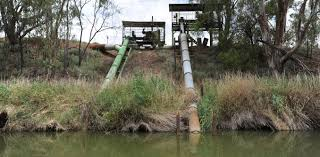Is the Murray-Darling Basin Plan broken?

A recent expose by the ABC’s Four Corners has alleged significant illegal extraction of water from the Barwon-Darling river system, one of the major tributaries of the Murray River. The revelations have triggered widespread condemnation of irrigators, the New South Wales government and its officials, the Murray-Darling Basin Authority and the Basin Plan itself.
If the allegations are true that billions of litres of water worth millions of dollars were illegally extracted, this would represent one of the largest thefts in Australian history. It would have social and economic consequences for communities along the entire length of the Murray-Darling river system, and for the river itself, after years of trying to restore its health.
Water is big business, big politics and a big player in our environment. Taxpayers have spent A$13 billion on water reform in the Murray-Darling Basin in the past decade, hundreds of millions of which have gone directly to state governments. Governments have an obligation to ensure that this money is well spent.
The revelations cast doubt on the states’ willingness to do this, and even on their commitment to the entire Murray-Darling Basin Plan. This commitment needs to be reaffirmed urgently.
Basic principles
To work out where to go from here, it helps to understand the principles on which the Basin Plan was conceived. At its foundation, Australian water reform is based on four pillars.
1. Environmental water and fair consumption
The initial driver of water reform in the late 1990s was a widespread recognition that too much water had been allocated from the Murray-Darling system, and that it had suffered ecological damage as a result.
State and Commonwealth governments made a bipartisan commitment to reset the balance between water consumption and environmental water, to help restore the basin’s health and also to ensure that water-dependent industries and communities can be strong and sustainable.
Key to this was the idea that water users along the river would have fair access to water. Upstream users could not take water to the detriment of people downstream. The Four Corners investigation casts doubt on the NSW’s commitment to this principle.
2. Water markets and buybacks
The creation of a water market under the Basin Plan had two purposes: to allow water to be purchased on behalf of the environment, and to allow water permits to be traded between irrigators depending on relative need.
This involved calculating how much water could be taken from the river while ensuring a healthy ecosystem (the Sustainable Diversion Limit). Based on these calculations, state governments developed a water recovery program, which aimed to recover 2,750 gigalitres of water per year from consumptive use, through a A$3 billion water entitlement buyback and a A$9 billion irrigation modernisation program.
This program hinged on the development of water accounting tools that could measure both water availability and consumption. Only through trust in this process can downstream users be confident that they are receiving their fair share.
3. States retain control of water
Control of water was a major stumbling block in negotiating the Murray-Darling Basin Plan, because of a clash between states’ water-management responsibilities and the Commonwealth’s obligations to the environment.
As a result, the Murray-Darling Basin Authority sits outside of both state and Commonwealth governments, and states have to draw up water management plans that are subject to approval by the authority.
The states are responsible for enforcing these plans and ensuring that allocations are not exceeded. The Murray-Darling Basin Authority cannot easily enforce action on the ground – a situation that generates potential for state-level political interference, as alleged by the Four Corners investigation.
4. Trust and transparency
The Murray-Darling Basin Plan was built on a foundation of trust and transparency. The buyback scheme has transformed water into a tradeable commodity worth A$2 billion a year, a sizeable chunk of which is held by the Commonwealth Environmental Water Office.
Water trading has also helped to make water use more flexible. In a dry year, farmers with annual crops (such as cotton) can choose not to plant and instead to sell their water to farmers such as horticulturists who must irrigate to keep their trees alive. This flexibility is valuable in Australia’s highly variable climate.
Yet it is also true that water trading has created some big winners. Those with pre-existing water rights have been able to capitalise on that asset and invest heavily in buying further water rights, an outcome highlighted in the Four Corners story.
More than A$20 million in research investment has been devoted to ensuring that the ecological benefits of water are optimised – most notably through the Environmental Water Knowledge and Research and Long Term Intervention Monitoring programs. What is not clear is whether water extractions and their policing have been subjected to a similar degree of review and rigour.
What next for the Murray-Darling Basin?
The public needs to be able to trust that all parties are working honestly and accountably. This is particularly true for the downstream partners, who are the most likely victims of management failures upstream. Without trust in the upstream states, the Murray-Darling Basin Plan will unravel.
State governments urgently need to reaffirm their commitment to the four pillars that underpin the Murray-Darling Basin Plan, and to reassure the public that in retaining control of water they are operating in good faith.
Finally, rigour and transparency are needed in assessing the Basin Plan’s methods and environmental benefits, and the operation of the water market. The Productivity Commission’s review of national water policy, and its specific review of the Murray-Darling Basin Plan next year, will offer a clear opportunity to reassure everyone that the A$13 billion of public money that has gone into water reform in the past decade has been money well spent.
Only then will the fragile trust that underlies the water reform process be maintained and built.
Original article posted in The Conversation, July, 2017.
